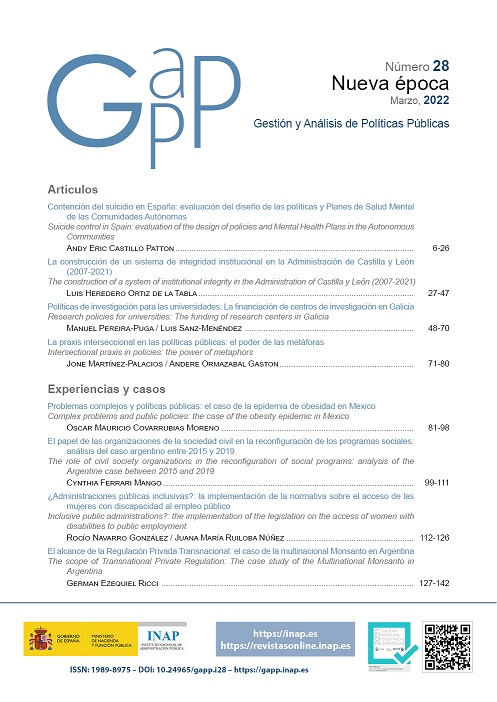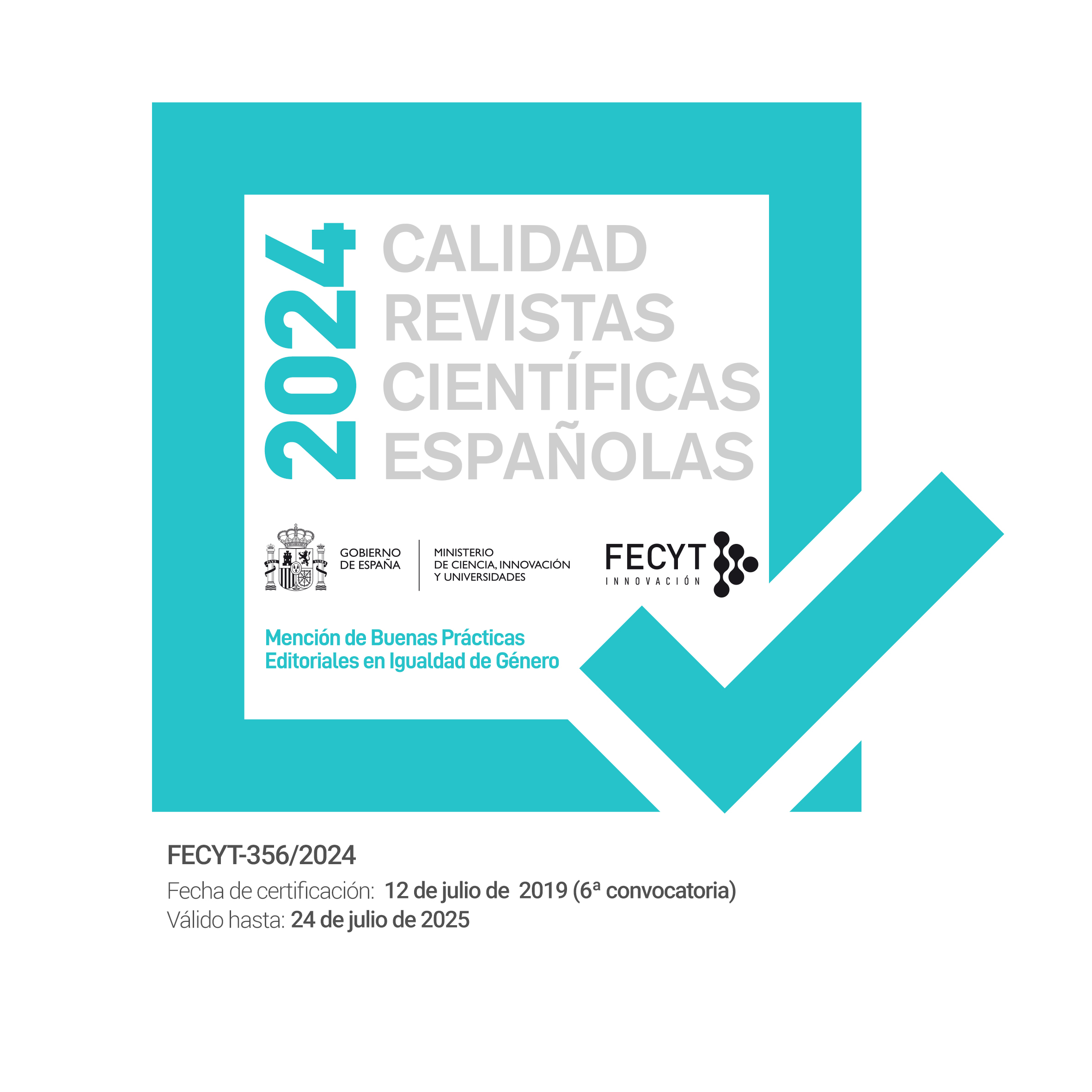Intersectional praxis in policies: the power of metaphors
DOI:
https://doi.org/10.24965/gapp.i28.10906Keywords:
Feminist Critical Theory, Intersectionality, Democratic Deepening, Marked Bodies, Public ActionAbstract
In political and administrative contexts in which the practices of the new public management have been installed, public policies are oriented towards efficiency, in sense of organizing public resources to the accumulation of capital in any of his forma. Faced with this reality, Feminist Critical Theory proposes to structure public action in non-binary form. This text explores the possibilities of the tool of intersectionality for that purpose. To this end, the metaphoric thought and the metaphor of marked bodies is presented as potentially useful in the design, implementation and evaluation of public policies.
Downloads
References
ARADIA (2021). Espacio para la profundización democrática. Proyectos. Recuperado el 28 de octubre de 2021 de https://www.aradiacooperativa.org/acompañamiento/
Arnstein, S. (1969). A ladder of citizen participation. Journal of the American Institute of Planners, 35(4), 216-224. https://doi.org/10.1080/01944366908977225
Bezez, P. (2020). Le nouveau phénomene bureaucratique. Le gouvernement par la performance: entre bureaucratisation, marché et politique. Revue française de Science politique, 70, 21-47. https://doi.org/10.3917/rfsp.701.0021
Boltanski, L. y Chiapello, E. (2002). El nuevo espíritu del capitalismo. Akal.
Bourdieu, P. (1972). Esquisse d’une théorie de la pratique. Droz.
Chevallier, T. (2019). Résister à bas bruit aux catégorisations institutionnelles dans des dispositifs de participation à Berlin. Participations, 25, 109-138. https://doi.org/10.3917/parti.025.0109
Collins, P. H. (2019). Intersectionality as critical social theory. Duke University Press.
Collins, P. H. (1990). Black Feminist Thought. Knowledge, consciousness, and the politics of empowerment. Routledge.
Collins, P. H. (1986). Learning from the ousider witin. The sociological significance of Black Feminist thought. Sociological Problems, 33(6), 14-32. https://doi.org/10.2307/800672
Collins, P. H. y Bilge, S. (2016). Intersectionality. Polity Press.
Connell, R. (2005). Advancing Gender Reform in Large-scale Organisations: A New Approach for Practitioners and Researchers. Policy and Society, 24(4), 5-24. https://doi.org/10.1016/S1449-4035(05)70066-7
Crenshaw, K. (1989). Demarginalizing the Intersection of Race and Sex: A Black Feminist Critique of Antidiscrimination Doctrine, Feminist Theory and Antiracist Politics. University of Chicago Legal Forum, 1989, article 8. https://chicagounbound.uchicago.edu/uclf/vol1989/iss1/8
Davidson, S. (1998). Spinning the wheel. Community planning, 1, 14-15. Recuperado el 28 de octubre de 2021 de https://sarkissian.com.au/wp-content/uploads/sites/13/2009/06/Davidson-Spinning-wheel-article1998.pdf<
Dye, T. R. (1972). Policy Analysis And Political Science: Some Problems At The Interface. Policy Studies Journal, 1, 103-107. https://doi.org/10.1111/j.1541-0072.1972.tb00077.x
Esteban, M. L. (2013). Antropología del cuerpo. Bellaterra.
Farinaz, F., Lépinard, E. y Roca i Escoda, M. (2016). L’intersectionalité: enjeux théoriques et politiques. La Dispute.
Fontaine, G. (2015). El análisis de políticas públicas. Conceptos, teorías y métodos. Anthropos-FLACSO.
Fraser, N. y Jaeggi, R. (2019). Capitalismo. Una controversia desde la Teoría Crítica. Morata.
Fung, A. y Wright, E. (2003). Deepening Democracy: Institutional innovations in empowered participatory governance. Verso.
Hankivsky, O. y Kapilashrami, A. (2021). Beyond sex and gender analysis: an intersectional view of the COVID-19 pandemic outbreak and response [Policy Brief]. Global Policy Institute, Quen Mary University of London. https://www.qmul.ac.uk/gpi/media/global-policy-institute/Policy-brief-COVID-19-and-intersectionality.pdf
Hibou, B. (2012). La bureacratisation du monde à’ l’ére néoliberale. La découvérte.
Joon-ho, B. (dir.)(2019). Parásitos [película]. Barunson E&A.
Laval, C. y Dardot, P. (2015). La nueva razón del mundo. Gedisa.
López, S. y Platero, R. L. (2019). Cuerpos marcados. Vidas que cuentan y políticas públicas. Bellaterra.
Mansbridge, J. (1990). Beyond Adversary Democracy. The University of Chicago Press.
Martínez-Palacios, J. (2021). El giro participativo neoliberal. UPV/EHU.
Martínez-Palacios, J. (2017). Innovaciones democráticas feministas. Dykinson.
Marx, D. y Pérez-Bello, E. (2018). Gros, n’est pas un gros mot. Chroniques d’une discrimination ordinaire. Librio.
Orozco, A. P. (2017). Subversión feminista de la economía. Aportes para un debate sobre el conflicto capital-vida. Traficantes de Sueños. https://www.traficantes.net/libros/subversi%C3 %B3n-feminista-de-la-econom%C3 %ADa
Sandoval, C. (2000). Metodology of the Oppressed. Universidad de Minesota.
Van Barneveld, K., Quinlan, M., Kriesler, P., Junor, A., Baum, F., Chowdhury, A., Junankar, P. (Raja), Clibborn, S., Flanagan, F., Wright, C. F., Friel, S., Halevi, J., y Rainnie, A. (2020). The COVID-19 pandemic: Lessons on building more equal and sustainable societies. The Economic and Labour Relations Review, 31(2), 133-157. https://doi.org/10.1177/1035304620927107
Villasante, T. (2017). Democracias transformadoras. El viejo topo.
Warren, M. (2009). Governance-driven democratization. Critical Policy Studies, 3, 3-13. https://doi.org/10.1080/19460170903158040
Young, I. M. (2000). Inclusion and Democracy. Oxford University Press.
Downloads
Published
How to Cite
Issue
Section
License
Copyright (c) 2022 Gestión y Análisis de Políticas Públicas

This work is licensed under a Creative Commons Attribution-NonCommercial 4.0 International License.












